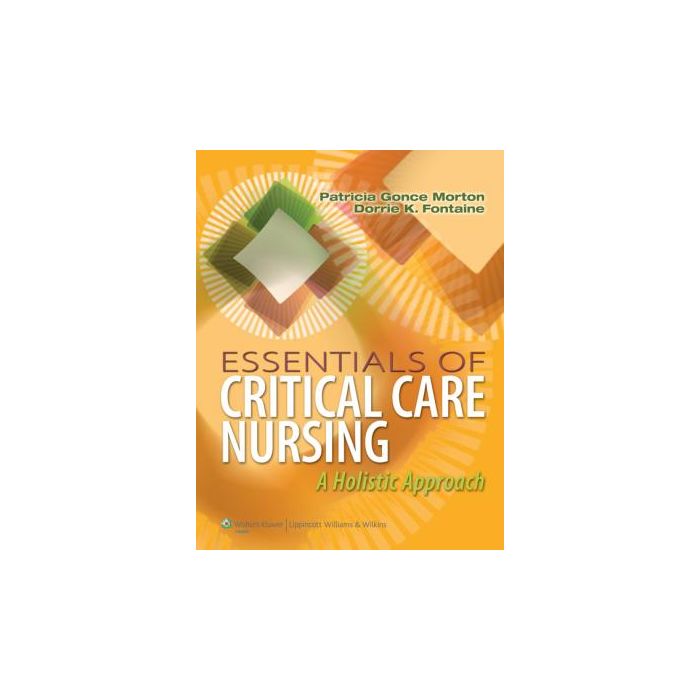Essentials of Critical Care Nursing: A Holistic Approach [Gonce Morton - LIPPINCOTT Williams and Wilkins]

- ISBN/EAN
- 9781609136932
- Editore
- LIPPINCOTT Williams and Wilkins
- Formato
- Brossura
- Anno
- 2012
- Pagine
- 536
Disponibile
50,00 €
Essentials of Critical Care Nursing: A Holistic Approach focuses on the most common disorders and technologies encountered by a critical care nurse today. It includes enough depth to enhance the reader’s full understanding of important topics and fully prepares the student for practice. The clear, concise writing style assists students in understanding the pathophysiological basis for illness and the strategies the critical care nurse uses in assessing and managing patients. This text contains information about important psychosocial concepts, legal and ethical issues, history and physical examinations, key laboratory and diagnostic tests, as well as key nursing interventions used in critical care.
Each chapter contains learning objectives to help focus the reader and a case study with critical thinking study questions that guide the student’s knowledge to practical application. Specially designed features appear throughout the text to assist students in providing competent and compassionate care to critically ill patients and their families:
Drug Therapy tables summarize information related to the administration and monitoring of drug therapy such as adverse effects, contraindications to use, measures that should be taken before administering the drug, as well as how to monitor a patient receiving the medication.
Diagnostic Tests tables present significant diagnostic test information including the purpose and method of testing, normal values, abnormal values, and nursing implications.
The Older Patient notes, appearing within the flow of the text, highlight information related to assessing and caring for older patients in the critical care setting.
Red Flag notes, also appearing throughout the text, highlight information that will help a critical care nurse recognize a serious problem or life-threatening change in a patient’s condition.
Collaborative Care Guides contain outcomes and interventions and describe how the health care team works together to manage a patient’s illness and minimize complications.
Evidence-Based Practice Highlights help the reader to understand the importance of research-based practice and its implications for nursing.
Health History boxes summarize aspects of the history that are important to explore to gain insight into the patient's current critical health problem.
Maggiori Informazioni
| Autore | Gonce Morton Patricia; Fontaine Dorrie K. |
|---|---|
| Editore | LIPPINCOTT Williams and Wilkins |
| Anno | 2012 |
| Tipologia | Libro |
| Lingua | Inglese |
| Indice | Part 1: The Concept of Holism Applied to Critical Care Nursing Practice Chapter 1: Critical Care Nursing Practice Chapter 2: The Patient’s and Family’s Experience With Critical Illness Chapter 3: Patient and Family Education in Critical Care Chapter 4: Ethical and Legal Issues in Critical Care Nursing Part 2: Essential Interventions in Critical Care Chapter 5: Relieving Pain and Providing Comfort Chapter 6: End-of-Life and Palliative Care Chapter 7: Providing Nutritional Support, Fluids, and Electrolytes Chapter 8: Dysrhythmia Interpretation and Management Chapter 9: Hemodynamic Monitoring Chapter 10: Airway Management and Ventilatory Support Chapter 11: Code Management Part 3: Cardiovascular System Chapter 12: Patient Assessment: Cardiovascular System Chapter 13: Patient Management: Cardiovascular System Chapter 14: Common Cardiovascular Disorders Part 4: Respiratory System Chapter 15: Patient Assessment: Respiratory System Chapter 16: Patient Management: Respiratory System Chapter 17: Common Respiratory Disorders Part 5: Renal System Chapter 18: Patient Assessment: Renal System Chapter 19: Patient Management: Renal System Chapter 20: Common Renal Disorders Part 6: Nervous System Chapter 21: Patient Assessment: Nervous System Chapter 22: Patient Management: Nervous System Chapter 23: Common Neurosurgical and Neurological Disorders Part 7: Gastrointestinal System Chapter 24: Patient Assessment: Gastrointestinal System Chapter 25: Common Gastrointestinal Disorders Part 8: Endocrine System Chapter 26: Patient Assessment: Endocrine System Chapter 27: Common Endocrine Disorders Part 9: Hematological and Immune Systems Chapter 28: Patient Assessment: Hematological and Immune Systems Chapter 29: Common Hematological and Immunological Disorders Part 10: Integumentary System Chapter 30: Patient Assessment: Integumentary System Chapter 31: Patient Management: Integumentary System Chapter 32: Burns Part 11: Multisystem Dysfunction Chapter 33: Shock and Multisystem Organ Dysfunction Syndrome Chapter 34: Trauma |
Questo libro è anche in:
